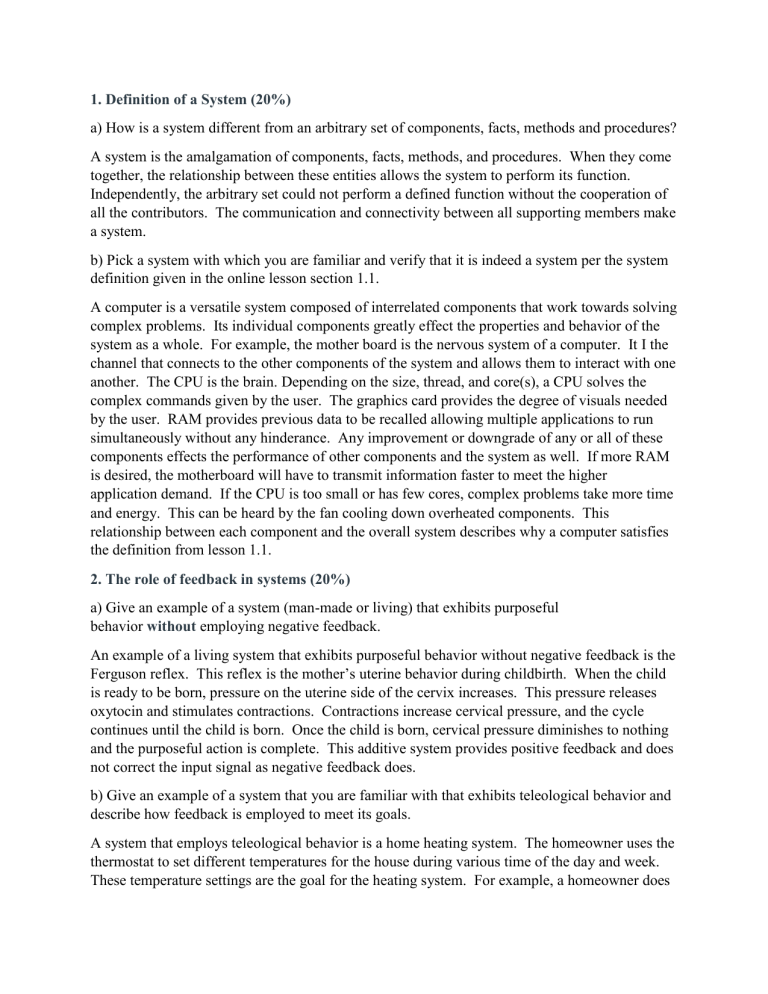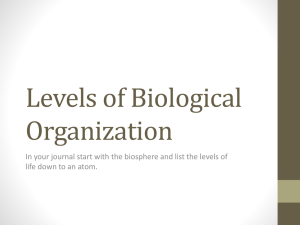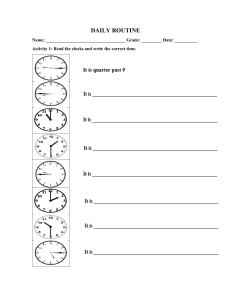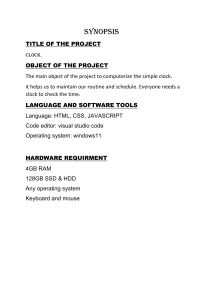
1. Definition of a System (20%) a) How is a system different from an arbitrary set of components, facts, methods and procedures? A system is the amalgamation of components, facts, methods, and procedures. When they come together, the relationship between these entities allows the system to perform its function. Independently, the arbitrary set could not perform a defined function without the cooperation of all the contributors. The communication and connectivity between all supporting members make a system. b) Pick a system with which you are familiar and verify that it is indeed a system per the system definition given in the online lesson section 1.1. A computer is a versatile system composed of interrelated components that work towards solving complex problems. Its individual components greatly effect the properties and behavior of the system as a whole. For example, the mother board is the nervous system of a computer. It I the channel that connects to the other components of the system and allows them to interact with one another. The CPU is the brain. Depending on the size, thread, and core(s), a CPU solves the complex commands given by the user. The graphics card provides the degree of visuals needed by the user. RAM provides previous data to be recalled allowing multiple applications to run simultaneously without any hinderance. Any improvement or downgrade of any or all of these components effects the performance of other components and the system as well. If more RAM is desired, the motherboard will have to transmit information faster to meet the higher application demand. If the CPU is too small or has few cores, complex problems take more time and energy. This can be heard by the fan cooling down overheated components. This relationship between each component and the overall system describes why a computer satisfies the definition from lesson 1.1. 2. The role of feedback in systems (20%) a) Give an example of a system (man-made or living) that exhibits purposeful behavior without employing negative feedback. An example of a living system that exhibits purposeful behavior without negative feedback is the Ferguson reflex. This reflex is the mother’s uterine behavior during childbirth. When the child is ready to be born, pressure on the uterine side of the cervix increases. This pressure releases oxytocin and stimulates contractions. Contractions increase cervical pressure, and the cycle continues until the child is born. Once the child is born, cervical pressure diminishes to nothing and the purposeful action is complete. This additive system provides positive feedback and does not correct the input signal as negative feedback does. b) Give an example of a system that you are familiar with that exhibits teleological behavior and describe how feedback is employed to meet its goals. A system that employs teleological behavior is a home heating system. The homeowner uses the thermostat to set different temperatures for the house during various time of the day and week. These temperature settings are the goal for the heating system. For example, a homeowner does not need a lot of heat at night when sleeping but wants it warm when he or she wakes up. If the temperature is set to 60F between 10pm and 5am and 65F between 5am and 8am, the thermocouple of the system will register the colder temperature at 5am and trigger the heat to turn on. When the temperature rises to 66F between 5am and 8am, the system will turn off or limit its operation to maintain the desired temperature. A home heating system uses the current temperature to correct the heat added to the living quarters and is an everyday teleological behavior we can thank for keeping us comfortable throughout the various seasons. c) Does a Westminster Chimes pendulum clock (a mechanical clock that plays a different melody to mark each quarter hour) exhibit teleological behavior? Explain. A Westminster Chimes pendulum clock does not exhibit teleological behavior. As stated in the essay, “there is no specific final condition toward which the movement of the clock strives.” It is a system of timed moving parts but it does not self-correct to reach a desired state or value. The clock simply continues. If any error occurs with the clock; such as an incorrect time, an outside source must interfere and correct the clock. The clock cannot correct itself. d) Does a GPS Disciplined Oscillator (GSPDO) exhibit teleological behavior? Explain. A GSPDO exhibits teleological behavior. This unit is used in timing applications and is the benchmark for coordinated universal time. The oscillator uses a microcontroller that adjusts according to frequency, phase, and position changes. These outputs are sent back for comparison to the input value and are used to have the most accurate synchronous behavior. Additionally, the oscillator adjusts for outside disturbances such as its age and temperature. This outside information also helps with its timing accuracy. The GSPDO teleological behavior allows humans to be connected on a global scale. 3. Machine Age versus Systems Age (20%) a) Compare reductionism (associated with Machine Age) and expansionism (associated with Systems Age). Reductionism is the belief that everything can be reduced, decomposed, or disassemble to simple indivisible parts. It was an analytical way to solve large complex problems. If the larger problem could be broken down to smaller problems and solved, then the simple solutions would sum to the overall solution. Expansionism is different but still compatible with reductionism. It focuses on all events and experiences being parts of a whole. Expansionism doesn’t deny the importance of parts but views them as being interrelated rather than being independent. Another way of comparing these two methods of thought is expansionism focusing on putting things together and reductionism taking things apart for comprehension. b) Compare the analytic mode of thinking associated with Machine Age and the synthetic mode of thinking associated with Systems Age. The analytic mode of thinking is considered outside-in thinking that focuses on the finite details of a system. Synthetic thinking is inside-out thinking and one can gain understanding by building on smaller systems repeatedly. This cannot be achieved by analytical thinking because things eventually become indivisible and you reach an endpoint. Continuous building provides more potential and possibilities for a whole system. Synthetic thinking, or systems approach when applied to systems, looks to improve the overall system outcome when each part is performing optimally. Synthetic thinking looks to prove the whole is greater than the sum of its parts. c) What are two problems that might be encountered if you attempted to use reductionism and the analytic mode of thinking to understand today's complex systems? If one were to use reductionism on today’s complex systems, he or she would spend an unimaginable amount of time trying to comprehend each individual part. Today’s systems have exponentially increased in the number of parts. Compare an automobile from 1939 to 2020. A car from the post-depression era was mostly mechanical and hydraulic. The only things electrical were the lights, wipers, battery, and starter. Today however, cars have cruise control, built in GPS navigation, satellite radio, defrosters, heating and cooling systems, diagnostic systems, etc. If one were to approach a car in 2020 with reductionism, he or she would be lost in details and waste time. Another problem that would occur is the loss for potential growth. If someone continually focuses on the simplest details to analyze a problem, he or she will fail to see what else could occur. Since reductionism is a very terminal way of thinking; analysis to indivisible parts, potential for growth or expansion is not considered. This can occur in companies that fail to innovate with a dynamic market. This said company will plateau, become uncompetitive, and eventually fail. This has happened on a nationwide scale and has been a limiting factor for many countries. 4. System life-cycle thinking/ Concurrent Engineering (20%) Four concurrent system life cycles are depicted in Figure 2.2 of your textbook. Complete the following sentences a) The primary (high level) activities associated with the Product Life cycle are __________ Preliminary design, detail design and development, production, product use, phase-out, and disposal. b) The primary (high level) activities associated with the Production Life Cycle Life are __________ Manufacturing, configuration design, and production operations. c) The primary (high level) activities associated with the Maintenance & Support Life Cycle are __________ Product and system support, configuration design, support and maintenance, and feedback. d) The primary (high level) activities associated with the System Retirement Life Cycle are __________ Product or system retirement, phase-out, disposal or recycling. e) Two benefits of considering product manufacturability and manufacturing configuration design starting in the conceptual design phase are __________ and__________. Quality and productivity f) One way system life-cycle thinking can promote environmental sustainability is by __________. Finding a way to recycle or reuse a product or system rather than throwing it away. Regeneration is another way to use older products to help with new regulations or requirements. 5. Systems Engineering influence on design (20%) a) Referring to textbook figures 2.12 and 2.13, make an argument for the application of systems engineering early in the system life cycle. You must refer to these figures to receive full credit. According to figure 2.13, Systems engineering has the highest influence on design in the early stages of a project; particularly in the conceptual system design phase. The overall view requires little system specific knowledge but sets a plan for the project and guidelines for others to follow. According to figure 2.12, the systems engineering approach can easily be changed in the beginning, the commitment to cost is lower as well as the cost incurred. When one starts a project with this approach and needs to make major design change, the consequences are much less severe than at a later stage. If one uses the systems engineering approach at later stages, such as the detail design and development stage, he or she won’t have much of an influence on the design; according to figure 2.13. Finally, figure 2.12 shows the exponential differences in applying system engineering thought at later stages. After the conceptual/preliminary design phase, change, commitment, and cost incurred are much more severe and could ultimately lead projects to reach the most common outcome; failure. The overview that the system engineering approach provide is extremely beneficial, if it is used at the beginning of a product/system life cycle.






